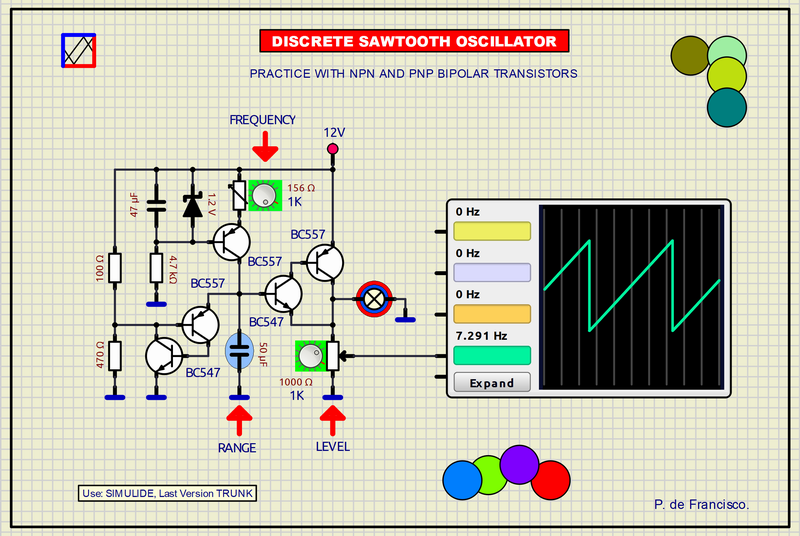336__DISCRETE SAWTOOTH OSCILLATOR
Quote from Defran on December 11, 2023, 3:55 pm
336_DISCRETE SAWTOOTH OSCILLATOR (Simulide R2116 or higher.)
The circuit in this example is an upward-sloping sawtooth oscillator whose frequency and output level are adjustable. A linear load can be applied to the output, such as an incandescent lamp, for example. If the frequency is very low, the linear luminous variation can be seen.
By changing the 50uF capacitor you can obtain other frequency ranges.
SCHEME:
The oscillator consists of the following parts:
a) The capacitor charging circuit controlled by the potentiometer.
b) Constant current circuit to obtain the linearity of the ramp.
c) Discharge circuit
c) Output circuit with a pseudodarlington amplifier structure.
SUBCIRCUITS:
This example integrates several subcircuits located in the "data" folder into the ZIP attached. This folder must always be next to the "sim1" scheme so that it can be executed. A subcircuit is a "custom" circuit that accumulates a set of Simulide base components (primitive function) to obtain a new or an adapted function. These subcircuits are treated by Simulide as another component of its own structure. User can create his own subcircuits or use the ones published here in your own designs once the procedure is known, explained in detail in the Simulide tutorials: https://simulide.com/p/subcircuits/
* Communication with the author: Simulide/User/Messages/Defran
P. de Francisco.

336_DISCRETE SAWTOOTH OSCILLATOR (Simulide R2116 or higher.)
The circuit in this example is an upward-sloping sawtooth oscillator whose frequency and output level are adjustable. A linear load can be applied to the output, such as an incandescent lamp, for example. If the frequency is very low, the linear luminous variation can be seen.
By changing the 50uF capacitor you can obtain other frequency ranges.
SCHEME:
The oscillator consists of the following parts:
a) The capacitor charging circuit controlled by the potentiometer.
b) Constant current circuit to obtain the linearity of the ramp.
c) Discharge circuit
c) Output circuit with a pseudodarlington amplifier structure.
SUBCIRCUITS:
This example integrates several subcircuits located in the "data" folder into the ZIP attached. This folder must always be next to the "sim1" scheme so that it can be executed. A subcircuit is a "custom" circuit that accumulates a set of Simulide base components (primitive function) to obtain a new or an adapted function. These subcircuits are treated by Simulide as another component of its own structure. User can create his own subcircuits or use the ones published here in your own designs once the procedure is known, explained in detail in the Simulide tutorials: https://simulide.com/p/subcircuits/
* Communication with the author: Simulide/User/Messages/Defran
P. de Francisco.
Uploaded files:
